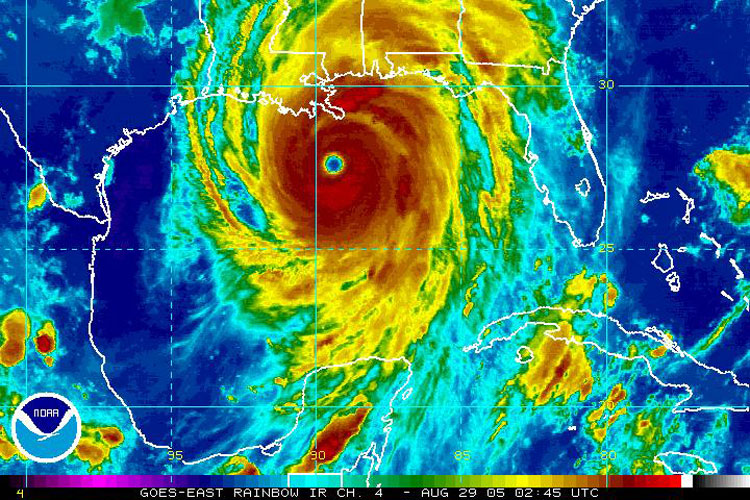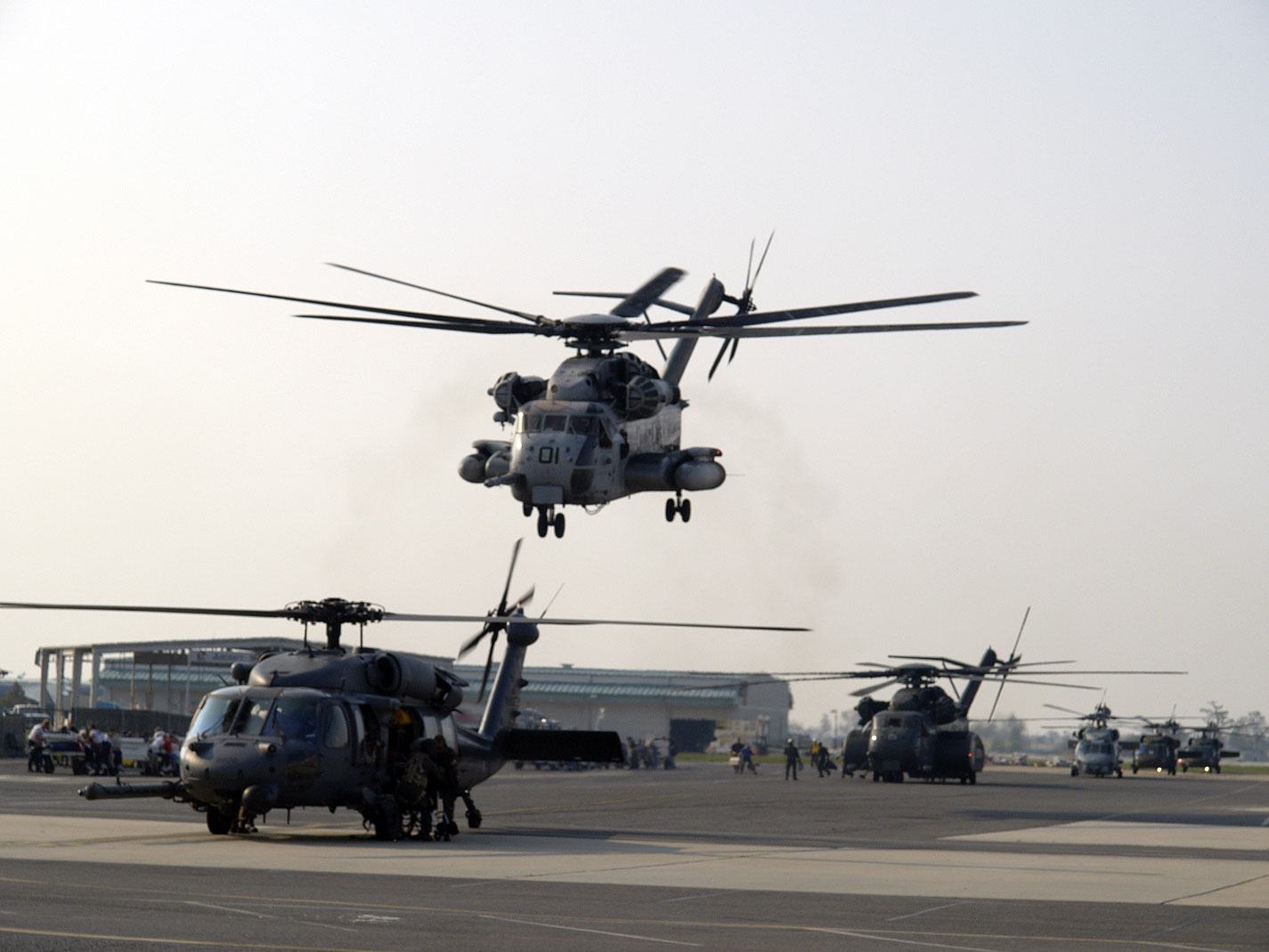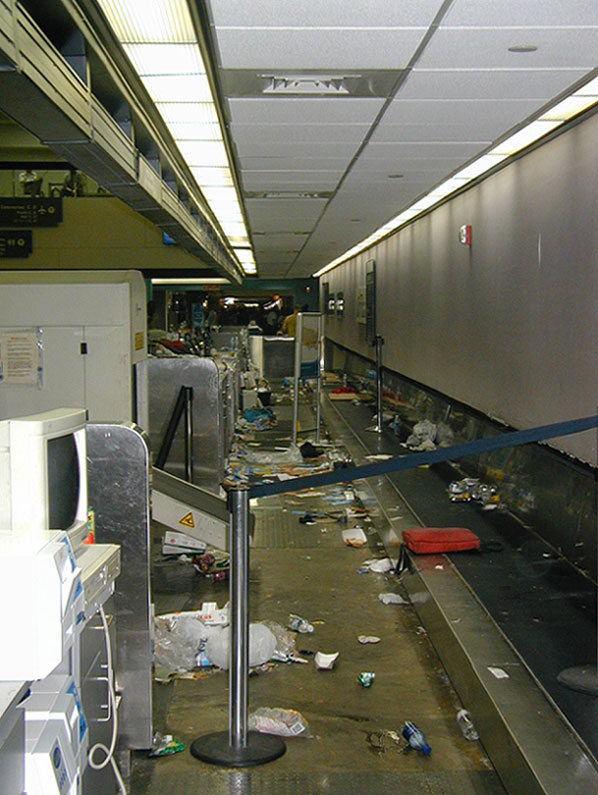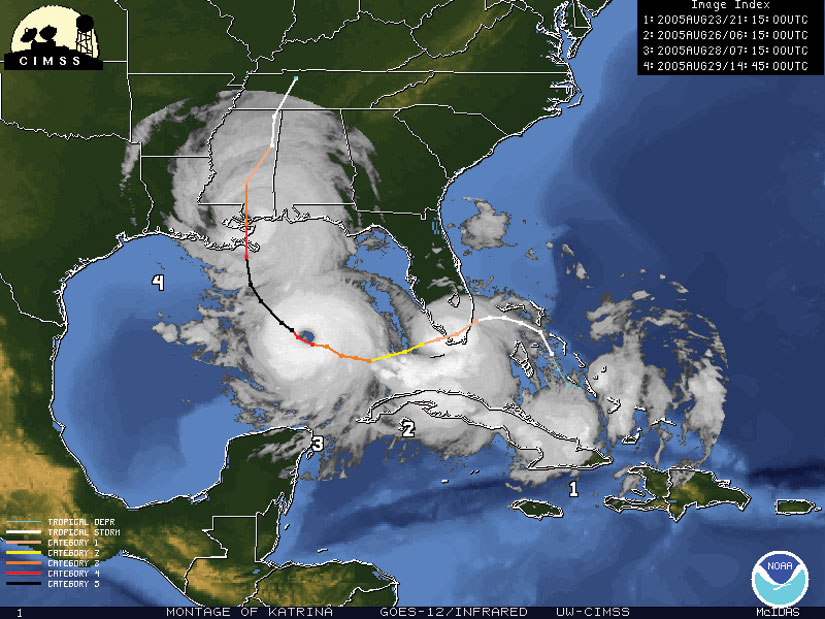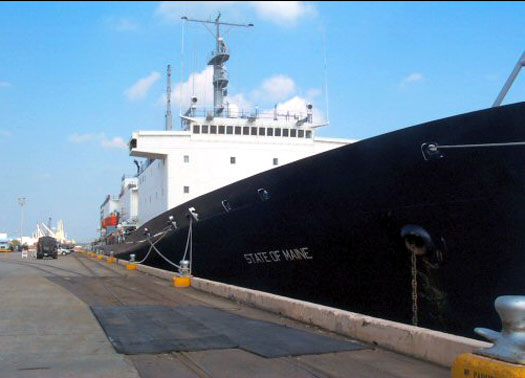From The PMO Desk: Hurricane Katrina Aftermath
Paula Campbell, Port Meteorological Officer, National Weather Service, New Orleans, LAPhotos Courtesy of Michael Rieger, FEMA
I have been asked to share some of my life experiences as Port Meteorological Officer (PMO) in New Orleans during the events of Hurricanes Katrina and Rita. Thanksgiving has just passed I have a lot to be thankful for. I am alive, I have a job, I have found a new place to live here in Jefferson Parish (that in itself is a miracle), and all of my friends and co-workers are accounted for. I think that not only for me, but also for all of Louisiana, Mississippi and Texas, that new meaning will be held for this holiday season of thanks and goodwill. It will be hard to keep this "PMO account of events" in a "PMO" perspective, because when something of this magnitude happens, survival instinct pulls you through, which has nothing to do with business. Just staying alive, making wise decisions, and making sure the ones close to you are taken care.
Leading to the week of Katrina, I drove to Pascagoula and Gulf Port, Mississippi to brief ships on Katrina, as well as calibrate their barometers. I wanted them to send us good observations while they were heading out and away from the Hurricane. On return to my office, which is located at the New Orleans Louis Armstrong International Airport, Katrina looked like she would move a bit to the east and send her worst to the Florida panhandle. I was very sick with a fever (strep throat) and Friday I called in sick, took my medicine and slept all day and night. Saturday morning I was awakened by a phone call from my sister who was very concerned with the new projected path of Katrina. The last projected track I saw, Katrina was going towards the Florida panhandle. Having confirmed the new path on the National Hurricane Center website and uttering a few choice words (all of you salty sailors out there would be very proud), I made Houston, Texas my destination. My immediate thought was that all of my ships would be deviated from New Orleans, with most going into Houston. The workload of the PMO in Houston would climb with the increase of incoming vessels. Once there and established, I could continue to provide full support to the Volunteer Observing System (VOS) program. I immediately called and made reservations for a Houston hotel that was pet friendly. I reserved it for five days, starting on Sunday. I proceeded to email my ships, which were in the vicinity of concern, giving them an update with attachments of the latest track and guidance of Katrina. My home computer was the last thing I dismantled, so that I could send out the most recent updates to my ships up to one half hour before leaving my apartment on Sunday Morning. After sending my last Katrina update and signing off, it really hit me how seriously scary this situation was becoming. With some humor and sadness, I printed the track and tacked it up on my bedroom wall. My next-door neighbor wouldn't leave without me, so on Sunday morning, with my car stuffed with my computer, personal effects I hold dear to my heart, some clothes and my two cats, we caravanned to Texas. It took us 14 hours to get to Houston.
Houston
Upon arrival in Houston, I unpacked, fed the cats, and turned on the TV. My God, already in New Orleans and on the Mississippi Gulf Coast all hell was beginning to break loose. Telephone lines and communications were already starting to break down in Louisiana. The 504 and 985 exchange was becoming hopelessly overloaded, and calls were not getting through. It was only for the fact that I had a cell phone from my previous residence in South Carolina that I was able to get through to anyone at all. The lesson learned here is to have redundant but separate forms of communications to ensure uninterrupted communications. With my phone, I was able to call my emergency contact number and report my whereabouts. I was quickly accounted for, which was a problem for many agencies.
The TV was watched constantly for any news or updates on all things Katrina. The amount of people crammed into this hotel was unbelievable. The staff of this hotel should be commended for doing as well as they did under the circumstances. The first day people were actually optimistic and almost giddy. After the second day, the writing was on the wall_people were running out of money, and New Orleans and much of the western Gulf Coast were in ruins. There was nowhere for people to return to, and the hysteria was already glaring. Reality set in, and it was horrible to watch. People were taking the food from the continental breakfast and piling it into their bags, knowing they were going to have to leave and food would be scarce. Many people were running out of money, since most were only prepared to stay for two to three days. Tempers were starting to run thin, and the mood was changing fast and for the worse. It was becoming desperate. I was very ready to leave by Friday morning sick or not. I called my friend Mike Kennedy, the Electronics Supervisor at the Houston Forecast Office. Mike and his wife Bernice were ready to take me in for as long as needed. I also kept in close contact with Chris Fakes, the Houston PMO. He was ready and waiting to take me in and get me started working out of the Houston office.
On Monday, feeling much better from borderline pneumonia, I was able to sit in on the NWS Southern Region conference call concerning the impact of Katrina. My parent office in Slidell was devastated and a friend/co-worker, Jake, was missing. It was like listening to an old radio show. It seemed so surreal. Things and places were just gone. There were no voice communications with the Slidell weather office, and information was sent via text messages to various people who conveyed things the best they could. It would be days before a vital communication link would be formed between the Slidell office and the outside world. There was no word yet on the National Data Buoy Center located at the Stennis Space Center in Southwestern Mississippi. Chris and I were standing by to see if there was any information on the VOS management team in Mississippi. No news.
I was now temporarily assigned (TDY) to the Houston weather office and needed to get my things in order. For me to be 100% useful in Houston, it would be necessary to take a trip back to New Orleans and gather my PMO equipment as well as my Government Vehicle. This way Chris and I could split the large area he covers. Jefferson Parish in Louisiana was going to allow a small window of opportunity for residents to return and gather belongings. This was a good time to go. Mike Kennedy got his truck ready, so he could assist me in getting anything I could salvage from my apartment and to recover my PMO tools and vehicle located at the New Orleans airport. We departed Monday evening, drove to Baton Rouge, slept in the truck until 5A.M., and then set out for Kenner. We timed it so that we would get to the I-10/Hwy 61 intersection right at the 6 A.M. curfew lift time. There was no gasoline available anywhere. Strict curfews were in place, and looting was rampant. Women were advised not to go anywhere alone under any circumstances. New Orleans was now a dangerous and volatile area. I-10 was blocked from the Hwy 61 exit into New Orleans. Only emergency vehicles could use I-10 from that point on. Convoys and emergency vehicles were streaming through with lights and sirens. Once on Hwy 61, it was slow going. After we arrived in the vicinity of Convent, Louisiana we started to see some damage, and, by the time we got to the airport, things got bad fast. The closer we got to my apartment, the more it looked like a bomb went off. Once inside, I got what I could, which wasn't much, since mold was already taking hold. My poor fish looked like a science experiment gone bad. However, I had a new sunroof in my bedroom where the roof used to be. In my kitchen, sludge was dripping from the cabinets. Another life lesson came with my refrigerator-that smell will stay with me forever (and don't trust those new stretch heavy-duty garbage bags, they do break).
Mike and I drove to the airport where my PMO office is located and my Government Van was parked. There were no traffic lights, and there were lines, trees, telephone poles, debris, etc., covering the roadways and the parking lot; creative driving was a must. Most of the vehicles left behind had major damage due to projectiles. My van was the only vehicle that still had the glass somewhat within the window frame; it was shattered but still in place. Mike checked to make sure that water had not gotten into the vital engine parts and topped off the gas tank with the gas we carried from Texas. Clear packing tape and lots of duct tape were the tools of choice for covering the entire passenger side windows in order to safely drive the van back to Houston.
The next task was getting to my office, which is actually located underneath concourse C, the American Airlines terminal. By now the airport had become the main Army Combat Support Hospital. This is also where they housed some of the National Guard, Army, Air Force, Navy, Marines, Federal Marshals, and reservists. All the normal entryways were closed, barricaded, or manned by guards holding rifles. I was shown the "new" main entryway and was approached by the duty officer. After showing my Government and Airport I.D.'s, I was waved through. The tarmac was cluttered with National Guard Black Hawk Helicopters, ambulances and more helicopters. Between the helicopters and ambulances, the tarmac was filled with military vehicles carrying soldiers and baggage carts ferrying people's personal effects, food, and garbage. It was busy, smelly, chaotic and very intimidating. I pulled up to my office, and on the stairwell were soldiers in full combat gear holding rifles. Flashing my badge, they allowed me to proceed to the door. I had to walk through the room that was normally the FAA contract weather observer's space to get to my office. The only light in the observer's office was the sunlight streaming in from the open door. I woke up the Marshals who were camped out and sleeping in the office after working a midnight shift. I apologized and went on into my office. I gathered many of my things that I thought I would need in Houston and threw them into my van. I then showed the Marshals where I kept my coffee pot and coffee, so that they could make a pot if they wanted to. I wished the guys well and made my way back to Mike. We then began the long caravan back to Houston. We made no stops, just drove straight back.
My government van needed to have all the glass replaced on the passenger side, so that was on the top of the "to do" list so that I could become operational. While waiting for my laptop to become operational, Chris Fakes (PMO Houston) gave me an orientation on the Texas Port situation and showed me around my new temporary work area. Because of the devastation in the Slidell forecast office, getting my laptop operational took much longer than expected. Consequently, I was not able to communicate with my ships for a lot longer than I had hoped. As before, we discovered that vital communications are one of the first things interrupted during an event like this. In addition to trying to become operational, I was trying to recover my personal effects, deal with the loss of my home, and my life as I knew it. I had to register with FEMA as well as register with the Red Cross, which is no small accomplishment. The Red Cross would help me obtain prescriptions for the medications that I lost in the storm. In the past week I had been in moldy, filthy areas, splattered with putrid food, and scooped up swollen decomposed fish. Also, with a tell tale smell I will never forget, it was obvious that there was raw sewage close by. Because I was exposed to these things, and would continue to be exposed, I needed to protect myself from disease. First things first, I went back to the shelter and got a tetanus shot as recommended.
On Monday, the 12th of September, my laptop was fully operational, and on the 14th, my government van was repaired. On Wednesday afternoon, the 14th, Mr. Trotter, my immediate supervisor from the Slidell office, informed me that he needed me back in New Orleans by Monday noon. I had to cancel ship visits and dismantle my laptop. The Slidell weather office wanted to include me as part of their team. They were able to secure a trailer for me to live in if I was unable to find housing elsewhere and Mr. Trotter made sure my needs were met. Mr. Trotter then assigned me with the new task of inspecting the damaged ports by collecting pictures and data for post Katrina economic impact studies. Mr. Trotter knew I would be able to have access to many areas most people could not get into. With my established working relationships with many of the leaders in the commercial and shipping industries, I would be able to obtain fast and accurate information and data for the reports. This was part of a huge collaborative effort. Like everyone else in the area, I felt overwhelmed with so much on my plate, along with taking care of my personal issues.
Getting around New Orleans was a major concern. I had to call the Port of New Orleans to find out the ship situation, and obtain authorization to drive beyond curfew times, and obtain permission to enter secured portions of the city. In addition, there was only one way into the Port since all other entries were now closed. I also had to obtain special permission to drive on the Causeway, which was restricted to emergency and official vehicles. The I-10 bridges into Slidell were destroyed, and Hwy 11 was a nightmare. There were curfews everywhere, nothing was open; absolutely no services were available. Most places didn't even have running water or electricity. There were entire areas throughout lower Louisiana that were just not accessible.
I called the Port of New Orleans and the one person who I knew who could help me my friend Mr. Gary LaGrange, President/CEO for the Port of New Orleans. I met Mr. LaGrange over a year ago at the Port's Headquarters and he told me if there is anything I ever needed, I was to call him. Well, I took him up on his offer. His office came through and was very helpful. They took my information and faxed me the necessary papers that I needed to carry for full access anywhere I needed to go. They also provided directions on the one and only route to the ports. With Mr. LaGrange's help, I was able to drive most anywhere I needed to go.
New Orleans
Home at last. I am one of the lucky ones. We had electricity and running water at my new house. They said that the water was safe and that you could drink it, but I still don't drink water from the tap. From now on it will be bottled water. Even though there was electricity, there was no gas. I took cold showers for almost one month. I was so excited when that gasman came to turn on the gas for my hot water heater and dryer. A hot shower, finally. Then slowly things got better. My telephone service was turned on in early November. Still, quite a few people had no service. My cable TV and Internet came back on around mid-November. The house was in need of a lot of cleaning, prepping, and painting. Although my new house suffered some damage, the little area of Harahan LA made out pretty good. Harahan is 12 feet above sea level, which is pretty high for Louisiana standards.
Rita
Hurricane Rita was coming now. I decided to stay and ride this one out at my office in the airport. After all, it held up for Katrina, and it was still packed with military. I also really felt pretty good about my new little house and its ability to withstand Rita's wrath.
My Office
Throughout the storm there was only emergency lighting in the FAA workspace and no lighting in my office or the bathroom, so I made sure I always had a flashlight in hand. I was so afraid of the large cockroaches that were taking over the airport. Garbage all over the tarmac and alongside of the dumpsters was piled high. Flies and other flying insects were abundant. The smell was horrible. The baggage carts were left full and scattered all over the airport grounds. Fortunately, some were filled with bottled water. Unfortunately, some were filled with garbage, including right next to my office door which were filled with personal effects and trash. I cannot help but wonder what happened to the people that this stuff belonged to. Prescription drugs, clothing, baby clothes, books, purses, dolls, eyeglasses, bibles, etc. This was so sad. Evacuated sick or dying people grabbed the most important items that they could carry in their hands, and it ended up here, in the garbage.
The lot where I usually park my van was taken over by the military. I was the only civilian who continued to park in this lot. In addition to my van, my car, and the military vehicles, the small lot was full of abandoned broken vehicles, many of the same cars that were there when I first recovered my van. I continued parking in the same area that I always had access to. The military left and was soon replaced with the drive through Red Cross and fully armed U.S. Marines.
Back to the Grind
Although the Port of New Orleans was open, ship traffic was light. My usual routes that I would take to visit Mississippi ports were essentially gone. The port of Gulf Port, home to the Chiquita and Dole wharf facilities, was destroyed. Route 90 was covered in debris, sand, and what was left of various casinos. All the homes along the Gulf coast were gone. The restaurants that I would stop to eat at on the way home from Mobile were gone. There were no services available to anyone. There were no gas stations, restrooms, restaurants or even rest areas. I was able to collect some good photographs for the Slidell Forecast office to use for their presentation to General Johnson (Director of NOAA's National Weather Service) and Bill Proenza (Southern Region Director). I visited my NOAA ships in Pascagoula, MS where I got to see what the storm surge did to my poor old Oregon II. That ship was lucky. Almost all the lines holding the ship gave way or slipped the bollards during the storm and only one line was left holding it to dock. A hole in the bow occurred when it took out a chunk of the cement dock. One picture that I took showed a water line mark in the dock's warehouse at 16 feet. The normal water line from the wharf is 10 feet below the pier, so Pascagoula took a 26 ft surge. My other NOAA Ship, Gordon Gunter, faired much better, and they gave me a copy of the barograph trace left from Katrina. The Marine Fisheries building and the entire Pascagoula area were pretty much destroyed. Both NOAA ships, Oregon II and Gordon Gunter, were now housing and feeding NOAA personnel, their families, as well as many others.
Driving through the city of New Orleans was spooky. Even at mid week and the middle of the day there were no people_anywhere. They were not letting people in for some time and the city was nothing but empty streets and empty buildings. To my delight, I got an email from a ship that wanted to become active in the VOS program, so I drove all the way down to Port Fourchon Louisiana, just to the west of Grand Isle. While there, I took a drive over into Grand Isle. Words cannot describe the widespread damage. I had to just pull the van over and cry. Just after that run, I had to go to Port Sulphur. This was one of the hardest hit areas and until then the only access was by helicopter. I kept driving south on Hwy 23, and it looked like I was driving into hell. It just got worse and worse. I put myself in these people's circumstances and I sure wouldn't want pictures of my living hell captured as a Kodak moment. I drove, and I cried, and I drove some more. I feel a mixed emotion about driving to these places. I am one of the few folks who got to behold the ultimate devastating power that a hurricane can impose on life and community. I had to see for myself these places that were destroyed. I lived, ate and worked in these places; I would drive through them to get to my ships. Slidell looked like nothing but piles of bricks and sticks. Even if you lived in these areas, you wouldn't recognize your own street. I drove through the 9th Ward District. I cannot describe how bad it is. Now instead of visiting ships loaded with goods for commerce, we have ships of mercy. The academy ships are speckled on our wharfs, housing and feeding workers and officials. The Navy ships and MSC ships are doing the same. I have been able to visit three of the Maritime Academy ships over the last couple of months and visit their crews, including Empire State, Sirius (the new Texas A&M Maritime ship), and State of Maine. I feel very privileged to have been able to give them support (as much or as little) in any way I could. Two of my ships that were in Port Sulphur were housing and feeding rescue and aid workers. Two of my cruise ships, Sensation and Ecstasy, are docked downtown housing and feeding. The cruise ship Holiday, who is normally out of Mobile AL, is now docked across from the NOAA ships in Pascagoula housing and feeding.
In the past most of my ships were concentrated in the Port of New Orleans, downtown. Now they are hither and yond. I spend a lot of time covering the Mississippi River and all the nooks and crannies that ships are able to access. Things are slowly trying to get back to normal. Commerce is slowly picking up and I am slowly getting my schedule back in tune. Like everyone else here, we are trying to work and clean up all at the same time. It is hard and frustrating. Everything here closes before I can get there, so I adjust my workdays. Stores never have enough people to run the registers. People are not coming back. Many businesses are just not able to run at all. If the people come back to run the businesses, there are no places for them to live. It is difficult at best and it will take this area a long time to recover.
I feel that it is important to end this account with this note to all of the ships that participate in the VOS program. I, as well as other PMOs had ships out in the Gulf submitting observations prior to Katrina and Rita. YOUR observations are the observations that were used in the mix to determine the projected path of these tropical systems. Your observations give vital information for analysts to determine such things as whether these storms are deepening or weakening. Your input makes a HUGE DIFFERENCE; I hope you really understand the impact marine observations have on these types of situations. Your data will be crunched for years by climatologists and scientists doing studies on tropical activity. Your data was what the experts used for ground truth to see if the models were in fact "on the mark". I want to thank the ships that provide observations for us. I think this active season reinforces the need for a program such as VOS. I am certainly proud to be a part of this program and I am proud to support the dedicated marine weather observers. I want to thank all of you who extended your prayers and good thoughts to me during this extraordinary time.
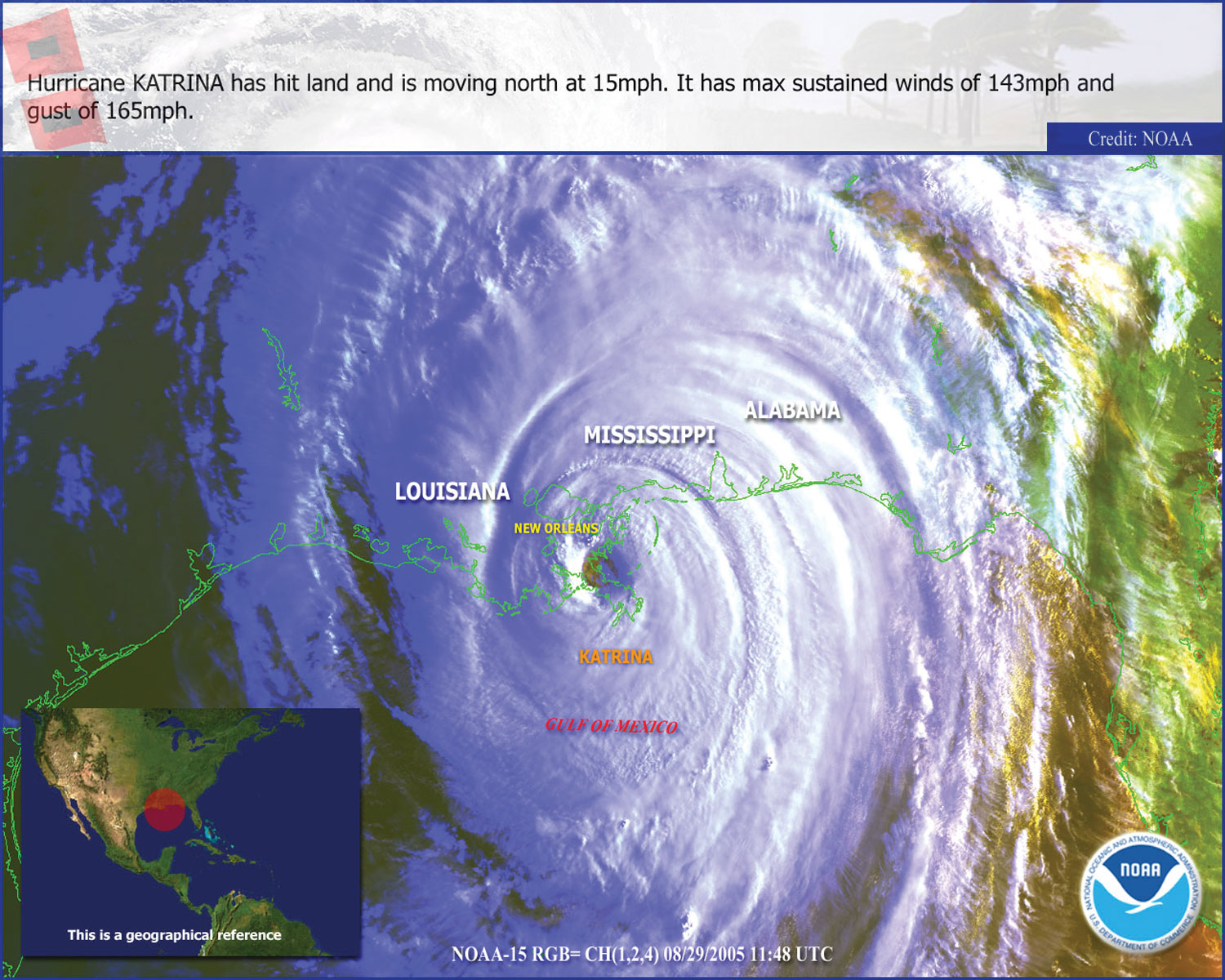
Image courtesy of http://www.srh.noaa.gov/hgx/gifs/Katrina.jpg

